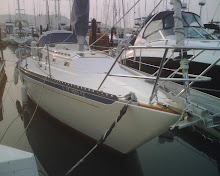 So, we took a great day sail over to Yelapa and moored there for the night. This is a small cove on the south side of Banderas Bay that was previously only accessible by boat, making it a favorite hangout of gringo hippies from California.
So, we took a great day sail over to Yelapa and moored there for the night. This is a small cove on the south side of Banderas Bay that was previously only accessible by boat, making it a favorite hangout of gringo hippies from California.The oft-heard saying goes something like this: "A Palapa in Yelapa Beats a Condo in Redondo..."
Anyway, it was a nice beach and cute town, with a warren of meandering narrow streets clinging to the steep hillside...it reminded me of some places in Italy's Cinque Terre. But, I have to conclude that Yelapa has "jumped the shark"; whereas it was formerly isolated and a hip little oasis, frequent day trips of tourist-filled pangas from PV have ruined it. The moment we got off the beach, we were hustled for a picture with an iguana on our shoulder, "native" handbags and other
 tschochkes (probably made in China), and restaurant touts.
tschochkes (probably made in China), and restaurant touts.The next day we headed back across the bay, initially hugging the dramatic southern coast. Some theorize that Banderas Bay was formerly a volcano, and the southern side is characterized by steep hills that jut dramatically out of the ocean. Very cool.
Our buddy Roger had a couple friends visiting, Sherry and Andrew, so to break things up, I took Andrew on Hurulu and Roger took Naomi and Sherry on Palapa. Andrew has done a lot of sailing and racing, and we decided to attempt a first for Hurulu: flying the spinnaker.

After sitting out in the middle of the bay for close to 5 hours, with zero wind-- literally, we were sailing along at 1 knot--around 1 pm the breeze kicked up. We tacked upwind to give us "sea room" for the (downwind) spinnaker run, and then got in position. Meanwhile, the breeze continued to gain rapidly....under mainsail alone, we were clocking off 6.5 knots, and the wind was ticking up to 20 knots.
Ok, at this point we should have probably just enjoyed our sail, sans-spinnaker, but I really wanted to fly one on Hurulu, and Andrew was as experienced a foredeck crew as we'd ever had aboard. I kept the helm steady with one hand while trying to film our first "chute launch" with the other.

With great suspense, he hoisted the halyard, and...the sail promptly twisted around itself. Andrew spent the next several minutes extending half his body off the boat's bow pulpit, untwisting. Meanwhile, the wind continued to pick up, above 20 kts.
Finally, he got it up! And the boat took off like a race horse. It was a wild ride-- somewhat analogous to strapping an uncontrollable jet pack to the stern-- but our downwind heading was taking us directly into the beach, very fast.
Finally, we had to drop it, and here's where it got a little nuts. The sail twisted again, and the pole swung out to the port side shroud, bending the pole, while the sail promptly dropp
 ed in the water and wrapped around the Monitor windvane. While Andrew pulled in the lines, I had to keep the boat from jibing, while also climbing monkey-like onto the Monitor's steel tube framing and unwrapping it.
ed in the water and wrapped around the Monitor windvane. While Andrew pulled in the lines, I had to keep the boat from jibing, while also climbing monkey-like onto the Monitor's steel tube framing and unwrapping it.Eventually we got it all together, back on board and stowed, and to make the most of the great wind, we flew the 170 jib-- and flew the boat! We were clocking off 7.5 knots and chased the (normally much faster) Palapa into the harbor.
Overall, despite the bent pole and a tear in the chute, it was an exciting experience. We're already reviewing the video (which mostly just shows chaos) and playing monday-morning quarterback, hoping to refine our gameplan for next time. Oh yes, there will be a next time!






























